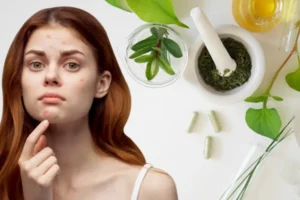 Acne or breakouts, including pimples, can be very frustrating especially if it is reoccurring and if it gets infected. Although this is more common in early adolescence and adulthood, for some people it can continue until late adulthood. General medical management and over-the-counter remedies include medication and topical treatments. However, oral medications and chemical treatments may not resolve the issue long term and some have risks and side effects.
Acne or breakouts, including pimples, can be very frustrating especially if it is reoccurring and if it gets infected. Although this is more common in early adolescence and adulthood, for some people it can continue until late adulthood. General medical management and over-the-counter remedies include medication and topical treatments. However, oral medications and chemical treatments may not resolve the issue long term and some have risks and side effects.
At our Ayurveda Wellness centres we see many frustrated patients with serious long term acne, seeking natural healing treatments. Our experienced team of Ayurvedic doctors and Ayurvedic practitioners can help find the cause of acne and identify how it can be managed and skin health restored by allowing the body to balance using natural healing processes.
Acne is a common chronic inflammatory condition of the skin with significant cutaneous and psychological disease burden. Acne vulgaris is related to the pilosebaceous follicle (hair follicle and sebaceous glands). It is characterized by formation of open and closed comedones, papules, pustules, nodules and cysts. Some studies found that several factors such as a disturbed hormonal (androgen) production, excess sebum production and hyperkeratinisation (a disorder of the cells lining the inside of a hair follicle) are involved in the cause of acne. Accumulation of excess sebum, epithelial cells and keratin obstruct the pilosebaceous follicle. This obstruction causes formation of a keratin plug and follicle swelling below the skin surface, resulting in acne lesion.
In Ayurveda, acne has been elaborated as one of the Kshudra Rogas (minor ailments). Acne is called Yuvanpidika and Tarunyapitika as it manifests in Yuva or Taruna (adolescence). As the disease is generally spread over the face and sometimes neck, back and shoulders and due to the inflammatory and scarring nature of lesions, acne is also called Mukhadushika. Acne is characterized by mildly or moderately painful bumps, firm to touch and filled with oil or sebum. In severe cases, they can be very painful.
Many authorities elaborate that Acne vulgaris is caused due to vitiation of Kapha and Vata doshas and Rakta dhatu (blood tissue). Vitiated doshas and dhatus (tissues) cause obstruction of the pilosebaceous unit of skin which causes acne. Further, rupture of acne causes scar formation. Also, vitiation of Vata and blood leads to hyperpigmentation of skin.
Since Vata, Kapha and Blood are mainly involved in the pathophysiology of Acne vulgaris, Acharya Charaka (a notable Ayurvedic scholar) has stated the involvement of Pitta Dosha along with blood impurity results in the manifestation of acne. As Ayurveda promotes the use of rationale in understanding the diseases, the symptoms manifested in Acne vulgaris can be correlated with the various doshas mentioned. This may appear a little complex for the layperson, basically, it identifies imbalances in each of the key constitutions in Ayuurveda, resulting in acne displaying different characteristics in each dosha. In the vitiation of Vata Dosha, there is pain present, watery discharges and scar formation. While in Pitta Dosha vitiation, there is inflammation and a burning sensation causing blackish discoloration. The vitiation of Kapha Dosha can lead to the formation of pus, swelling, oiliness, discharge and itching.
AYURVEDIC MANAGEMENT
In Ayurveda, mainly two types of treatments are described i.e., purification treatment (Shodhana Chikitsa) and palliative treatment (Shamana Chikitsa). In the purification treatment, it seeks to move or vitiate the disturbed Dosha in the body which are subsequently expelled out through the nearest route available. Once these Doshas are expelled, disorders due to Kapha and Pitta have a lesser chance of reoccurrences. Palliative treatment seeks to normalize the Doshas in their location to bring about a state of equilibrium of the Doshas in the bodytreatment for Acne
One of the best way to resolve skin issues in Ayurveda is by removing the toxins from the body, especially from the blood tissue. Skin inflammation (a Pitta imbalance) including acne is generally caused by toxins, therefore, cleansing the body by removing the toxins with special Ayurvedic cellular cleansing process called Panchakarma will allow the body to heal from inflammation. Below are the most common Panchakarma detox treatments suggested for managing Acne:
Purvakarma – Preparation for detoxing by improving digestive strength (Agni) with a simple diet and herbs/spices; consuming herbalised ghee to lubricate the channels followed by Ayurvedic a herbal massage such as Abhyanga and swedana(steam) treatments.
Pradhan karma – Main Detox: cleansing the toxins by performing virechana (Purgation) process by taking herbs which help cleanse the bowels.
Paschat Karma – Post detox diet and herbal plan to help the body with its natural healing process.
Herbal treatment
As palliative treatments, many Herbo-mineral compounds are advocated for both internal and external use. As the disease is spread mainly over the face, external applications have a greater impact on the features of Acne vulgaris. Medicines can be in powder form, paste, oil, ghee etc. The method advised for the application is based on assessment of the eruptions.

